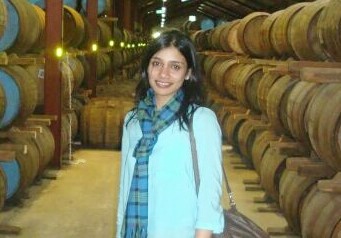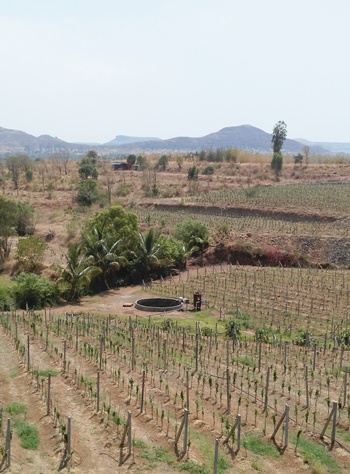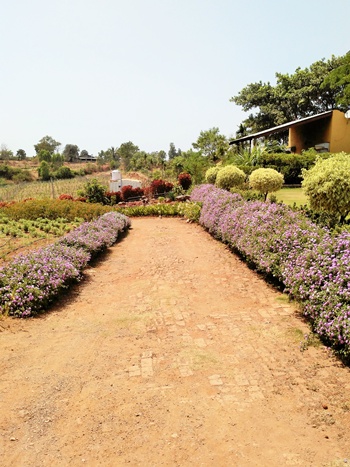Good vines make better wines
20 Aug 2016
 Aditi Pai, a former journalist with a news magazine, is the co-founder of Vallonne Vineyards along with her father Shailendra Pai. She now handles corporate communication and the wine brand's online and offline presence.
Aditi Pai, a former journalist with a news magazine, is the co-founder of Vallonne Vineyards along with her father Shailendra Pai. She now handles corporate communication and the wine brand's online and offline presence.
Her father Shailendra Pai is India's first vintner who has been closely associated with the wine industry for over three decades. He began his journey in the wine industry with Champagne India Ltd 30 years ago when he launched India's first ever sparkling wine in the European market. Since then, he has been extremely passionate about wines and set up his own winery, Vallonne Vineyards in 2008.
In this interview with Swetha Amit, Aditi Pai talks about how the idea behind Vallonne vineyards conceptualised, the experience of wining and dining inside the vineyards and also the evolution of the Indian market in the wine business.
How and when was the idea beyond Vallonne vineyards conceptualized? What is the significance behind the name 'Vallonee'? My Father Shailendra Pai has been involved with the wine industries since 1986. He was the vice president of Champagne India Ltd in the '90s and had an opportunity to market wines all over the world. In fact, he was the first person to launch sparkling wine in India. He subsequently moved on to other businesses, but his heart was always with wine. In 2006, he eventually decided to get back to where his passion lay and decided to set up a winery in India.
My Father Shailendra Pai has been involved with the wine industries since 1986. He was the vice president of Champagne India Ltd in the '90s and had an opportunity to market wines all over the world. In fact, he was the first person to launch sparkling wine in India. He subsequently moved on to other businesses, but his heart was always with wine. In 2006, he eventually decided to get back to where his passion lay and decided to set up a winery in India.
After purchasing the land in 2007, he decided to set it up in a manner, which had a complete French ambiance and orientation as he wanted this winery to be different from the existing players. He was clear about not wanting to get into mass production and focus only on producing small quantities instead. Inspired by some of the French wineries he had visited during his overseas travels, he wanted to replicate that experience to a certain level in India. That's how Vallonne vineyards came into existence.
The name 'Vallonne', in French, means cultivating land or slopes . Our vineyards have a sloping land and we decided to make the most of it. Therefore we didn't really change the contours of the land at all. We built it in such a way that our cellars were naturally underground, of course, keeping in mind the French orientation.
Could you elaborate a little about the vine to wine journey, ie right from the grape harvesting to how the wine is finally bottled and stored in barrels?
As most wine experts will tell you, 60-70 per cent of wine is actually made in the vineyards. So, we have ensured the good quality of grapes being grown in our vineyards by deploying our own horticulturists who work with farmers to make sure that we get the kind of fruit that we want.
We decide on things like the particular stage when we want to harvest the fruit, etc. Once this is taken care of, half the battle is won as the aroma and taste of the wine is a reflection of the conditions in which the grapes are grown. The interesting aspect here is that everything is mechanised and human intervention is involved only during the actual grape harvesting. Post that, the fermentation and bottling is all done by machines. Our oak barrels, where the wines are stored, come from Radoux which is the leading maker of wine barrels in France.
Wine tasting tours have become quite a norm and are popular among Indians going overseas for some years now. Did you ever anticipate a strong demand for it since your first harvest in February 2009? Yes, we did. When we started out, our philosophy was always about wine education, awareness and innovation. We wanted people to understand wines and not just perceive it as another alcoholic beverage. Wine tours and vineyard trails were already popular in the western world. This popularity was bound to grow in India once the awareness and appreciation for wines set in. In the last five years especially, Indians who have travelled abroad extensively have visited vineyards there and have developed a large interest in grapes and wines. This was something we had anticipated, which is why we chose a property with a picturesque setting and which was a little cut off from the hustle and bustle of the main town, in order to develop our wine tourism.
Yes, we did. When we started out, our philosophy was always about wine education, awareness and innovation. We wanted people to understand wines and not just perceive it as another alcoholic beverage. Wine tours and vineyard trails were already popular in the western world. This popularity was bound to grow in India once the awareness and appreciation for wines set in. In the last five years especially, Indians who have travelled abroad extensively have visited vineyards there and have developed a large interest in grapes and wines. This was something we had anticipated, which is why we chose a property with a picturesque setting and which was a little cut off from the hustle and bustle of the main town, in order to develop our wine tourism.
When you initially opened in Nashik, did you ever face any challenges due to the existence of major players like Sula? Was it difficult to make your market presence felt?
Well no. In fact it was beneficial to us as they had already laid the ground for us by making wine a popular drink in India. Since they are a well-known brand, a market for wines had already been created. However we don't expect to compete with Sula in sheer numbers as our ides are different. Our primary focus was to enhance the wine quality and the holistic wine experience for people. We weren't really aiming to sell large numbers in the retail market. We have confined ourselves to fewer places, which really appreciate good wine. Some of the places where our wines have a presence are Café Zoey and Pali Village Café in Mumbai. These outlets stock our wines without expecting us to come up with deals or schemes. Ultimately it's about reaching out to a niche segment i.e. the right kind of people who appreciate good quality wine.
Vineyards are more than just about wine tasting as they offer an unforgettable experience, which prompts customers to come back. Vallonne offers a comfortable stay and a restaurant that caters to south east Asian delicacies. Could you tell us more about this interesting concept of staying and dining inside the vineyards? When people initially started visiting our vineyards, we found that they wanted to spend more time basking in the wineries. They also wanted to enjoy some good food along with their wines. So we decided to experiment with south east Asian cuisine instead of the usual continental food that is normally offered with wine. We realized that the flavours of pan Asian cuisine actually complimented wines really well. This food with wine enhanced the experience for our guests further and that's when we decided to go a notch higher and offer stay options inside the vineyards.
When people initially started visiting our vineyards, we found that they wanted to spend more time basking in the wineries. They also wanted to enjoy some good food along with their wines. So we decided to experiment with south east Asian cuisine instead of the usual continental food that is normally offered with wine. We realized that the flavours of pan Asian cuisine actually complimented wines really well. This food with wine enhanced the experience for our guests further and that's when we decided to go a notch higher and offer stay options inside the vineyards.
We set up four rooms which overlooked the vineyards and the mountains. They have a very vintage feel to them, furnished with English furniture sourced from the Portuguese houses in Goa. They have been designed by us to ensure that it gives a homely feel for our guests. We don't have television sets, internet or any of the conventional forms of recreation that other resorts usually have. Our main focus was to enhance the vineyard experience along with a tryst with rural life. So we offer options like bullock cart rides, a visit to the farmer's cattle shed and cycling expeditions by the village side. The idea was never to create just another weekend resort but a unique experience and a getaway from hassles of city life.
What is the profile of customers who normally come to Vallonne and what months make it ideal to visit?
At our restaurant, we usually get people who primarily reside in Nashik. They range from anywhere between 20-65 years. The youngsters are the ones who have extensively travelled to wineries abroad and always make a favourable comparison with regards to their experience at Vallonne. We also have the expat community, business families, young professionals and diplomats visiting our vineyards. Families with young kids often look for a tryst with nature as they are not too keen on the idea of their kids always spending time in front of the television. While many visitors in our restaurant are from closeby areas, we also have travellers from Mumbai, Ahmedabad, Delhi and even Coimbatore, purely coming in for the vineyard experience. These are people who are genuinely interested in wines and appreciate them.
The best months to visit Vallonne would be between June-March. April and May can get quite hot though it's pleasant in the evenings. Our peak season starts in June and it's beautiful in the monsoons as our guests are treated to lush greenery, the view of the fog and mist up the mountains. In Nashik it doesn't rain throughout the day so guests can venture out during the dry spells. Winters are also quite pleasant in Nashik, so we have guests during Diwali and New Year as well.
Vallonne vineyards, which is spread over sprawling acres also sees the growth of some vegetables and fruits like papaya, onions, tomatoes, moong, etc. Do you have a contract with local farmers?
No. We have our own gardener there and four horticulturists. We set up another farm recently, Vallonne Agro, which only looks at cultivation of vegetables and fruits. The idea behind this concept is to promote the farm to table concept which is growing in popularity across the world. It emphasises eating local as you get the best flavours that way. Therefore, wherever we can, we are growing our own vegetables and fruits and serving it at our restaurant. For instance the papayas we grow are used in salads or served as breakfast. Green leafy vegetables like spinach are used in the main cuisine and it's the same case with tomatoes, onions and garlic. All these crops are cultivated without the usage of pesticides.
Vallonee wines specialises in boutique wines at affordable prices. What are your specialty wines? Any new creations that has taken the Indian market by storm? We launched our Rose and we were the first ones to launch the Cabernet Sauvignon Rose, which actually made people stand up and say that it was different from the rest. We had a winemaker and chef from France who said that our Rose was made exactly on the lines of Rose from France. It was a big compliment for us. Then we launched the Malbec. We were the first and still the only ones to do a reserve Malbec in India. It's primarily grown in Argentina and nobody in India does reserve Malbec. So when we launched it back in 2011-12, we were first ones and continue to be the only ones to specialise in this wine.
We launched our Rose and we were the first ones to launch the Cabernet Sauvignon Rose, which actually made people stand up and say that it was different from the rest. We had a winemaker and chef from France who said that our Rose was made exactly on the lines of Rose from France. It was a big compliment for us. Then we launched the Malbec. We were the first and still the only ones to do a reserve Malbec in India. It's primarily grown in Argentina and nobody in India does reserve Malbec. So when we launched it back in 2011-12, we were first ones and continue to be the only ones to specialise in this wine.
Then we also do a dessert wine which is made on the lines of Straw wine in France and again we are the only ones to do that. These are the three main varieties that have been innovations which did create a kind of a stir in the market and they were greatly appreciated. Last year we launched a 2009 vintage of the Cabernet Sauvignon, which has been aged for 52 months, both barrel and in the bottle. We have another variety called the Crimson Glory which is a blend of Malbec, Cabernet and Merlot.
How do you see the Indian market for wines today and the consumer preferences over the years? Have customers gone beyond their preference for sweet taste in wines?
It's definitely grown over the years. Since the time my father set up Vallonne in 2009 and we launched our first harvest in 2010, he has seen a marked rise in the awareness levels about wines.
People are serving wines at their house parties and consuming them during their night outs. They have also become a lot more appreciative of wines and are willing to try out different varieties by pairing them up with the right kind of cuisine.
Initially at wine festivals, we would have customers approach us and request for sweet wines. Earlier women would prefer white wines while men would enjoy their reds.
But that has also changed drastically over the years. Today, people show a preference towards red wines and our red wines are usually dry. Other than the dessert wine, which I mentioned earlier, we don't make sweet wines. Customers have also learnt to pick and choose the wines based on a certain aroma and flavour.
There are about 40 wineries in Nashik city. So what would you say sets Vallonne apart? And what are your future plans?
What sets Vallonne apart is that it's a boutique winery where the emphasis is more on quality than quantity. As mentioned earlier, we believe in innovation and look to bring something different to the Indian market. We have also paid a lot of attention to packaging and labelling as we consider labels to be our identity. We also offer a unique experience inside the vineyards and offer unconventional cuisine as an accompaniment to our wines.
Our future plans is to experiment in newer varieties of wine. We are also planning to expand our rooms by setting up more cottages inside the vineyards. The construction will start post the monsoons this year.






























